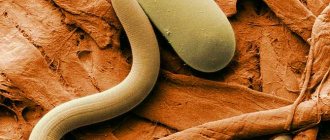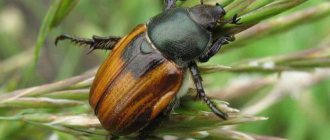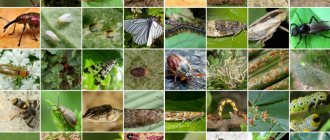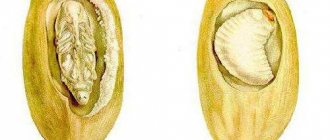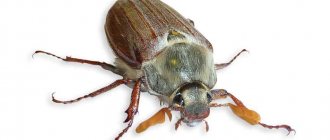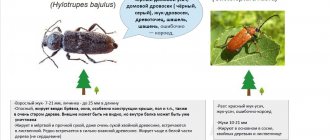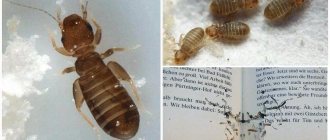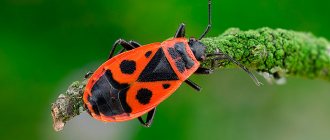Despite its small size, the bark beetle is capable of causing irreparable damage to forests and gardens in a short period of time, destroying huge tree stands. Its various species settle not only in living, but also in dead wood, turning it into dust and rendering building materials, wooden buildings, and furniture unusable. There are varieties of bark beetles that destroy food supplies.
- Where does he live?
- Characteristics and body structure Head
- Thoracic part
- Wings and elytra
- Limbs
- Abdomen
- Spruce beetle
- Larva
- Temperature method
To prevent a pest beetle invasion, you need to know what it looks like and what the danger of its appearance is. To combat the beetle and its offspring, the most effective methods should be used, as well as the necessary preventive measures.
More information about the pest
The bark beetle belongs to a large family of weevils and is divided into 2 large groups:
- sapwood;
- pine beetles.
The first parasitizes mainly on coniferous plants. Among the second there are species that can harm garden trees.
The adult insect of almost all bark beetles is a small, inconspicuous beetle, the total body length of which is from 1.5 to 5.1 cm. The elytra are black or dark brown.
The cephalothorax is massive, oval in shape. The head is at its bottom. If you look at the beetle from above, it is practically invisible. Just below the eyes in the middle of the head there is a small proboscis.
Adults do not feed on wood. Their main food is juice, which they suck from the green parts of plants using their proboscis. The main damage is caused by the larvae. They have an elongated body, white with a creamy tint, divided into distinct sections.
The bark beetle larva does not have legs, which are present in most beetle larvae. The head is massive, hard, ending in large jaws. This structure of this organ helps the larva to bite into the tree and crush it.
Almost all types of bark beetles have the described appearance. The differences are very minor.
Bored beetles and longhorned beetles also feed on wood. The first ones are very reminiscent of bark beetles. The latter are quite different from them - they have an oblong body up to 5 cm long and long (up to 70 - 80% of the body length) mustache. Both borers and longhorned beetles lay larvae in wood. Only more often not into living things, but into something from which houses or outbuildings are built.
Characteristics and body structure
Externally, bark beetles are very diverse. The appearance of the tree pest, the bark beetle, corresponds to the image and conditions of its life. But beetles also have common characteristics by which they are classified and belong to this subfamily. Color can range from light brown to black. The smallest bark beetles living in Russia have a body size of less than 1 mm, and their larger relatives reach 9 mm.
Head
Although the bark beetle is considered a close relative of the weevil, its head does not have a rostrum, like that of an elephant. It is a continuation of the body with a blunt forehead. The front of the head varies between sexes of the same species. The eyes are round and flat. The antennae are geniculate and short. The head is usually darker in color than the rest of the insect.
Thoracic part
There are three segments on the chest - on the upper side they are called anterior, mid, and posterior. From the bottom - prothorax, mid-thorax, metathorax. The most important is the pronotum, which can be: spherical, quadrangular, oval, triangular. Its lateral edges are slightly rounded, and there is a narrowing at the very top.
Dotted grooves are applied across the entire surface. The tubercles and denticles located on the pronotum are of specific importance. The triangular shield is strongly recessed and also covered with dotted lines.
Wings and elytra
The body of the bark beetle is covered with strong, well-developed elytra, under which are membranous wings necessary for the insect to fly. The wings cover the main part of the abdomen. An important difference between adult individuals is the characteristic notch on the back of the elytra. It is called a “wheelbarrow” and serves as a device for clearing passages of wood flour. The elytra have pronounced points in several rows.
Limbs
Thin paws are covered with sparse, hard hairs or have none at all. The hip part of the forelimbs is round, the hind limbs are transverse. On the flattened shins, tubercles protrude from the outer side. The front legs are short, the hind legs are longer.
Abdomen
The abdomen is located horizontally, consists of five rings, and is covered from the upper part by elytra. Females usually have a wider abdomen than males. There are organs for oviposition.
Why is it harmful?
Adult females and beetle larvae damage the bark of trees. When the female is ready to lay eggs, she gnaws through the wood to the bast (some species of the pest - to the sapwood). There, the female gnaws out a rather large (for her size) oval chamber, where she lays eggs. It is called the uterine.
When the larvae hatch, they begin to gnaw their way out, diverging in different directions from the camera. Since there are 20–40 eggs in one clutch, there will be the same number of “trenches” made by the pest.
Females and larvae of the bark beetle damage bast and sapwood. This has the most negative effect on garden trees and often leads to their death.
Basts are the “vessels” of plants. It is through it that water with inorganic substances dissolved in it flows from the roots to other parts of the tree. And then - organic compounds, including glucose, produced during the process of photosynthesis, disperse along the phloem from the leaves. Violation of the integrity of this tissue leads to the fact that some parts of the plant are left without nutrition. As a result, their death begins. As a result, the entire plant may die.
Sapwood is a tissue that stores stored nutrients. It helps plants survive the cold season. If the sapwood is damaged, the tree does not have enough resources for spring restoration, when the leaves have not yet blossomed, but nutrients are already needed. The plant may die.
Species of beetles that feed on conifers often lay eggs in houses and other buildings made of pine, spruce, and larch. The passages made by insects make the wood less durable and contribute to the onset of the rotting process.
Errors during construction
Construction logs must be cleared of bark and subjected to special treatment. PROSEPT 42 or Prosept Ultra can serve as protection against bark beetle.
Propset concentrated products
Timely processing of wood will prevent the appearance and development of beetles.
When constructing a structure, it is necessary to ensure the continued safety of all wooden elements of the structure. Traditionally, the process of building a wooden house looks like this: the first layer is a vapor barrier, then insulation and wind protection, the construction is completed by a ventilation gap and finishing material (siding). Moisture rushing from inside the house to the outside encounters a vapor barrier, a dew point appears, and condensation occurs. Thus, good conditions have been created for the proliferation of bark beetles in a wooden house and the germination of fungal spores, although the destruction of the wood that has begun will not be visible for a long time.
The point of view of specialists in building physics and technologists working in wooden house construction is that a vapor barrier is not needed when insulating a wooden house. For a house that is constantly in use, vapor barrier is detrimental. Internal sources of moisture: people's breath, steam from cooking, moisture from watering house plants, and the bathroom increase humidity.
Beetles may settle in after construction is completed
When ventilation shafts, door and window openings are open, the structure becomes accessible to beetles. If insects are found, it is necessary to urgently take all measures to destroy them. And the most important condition for success is timeliness.
An adult wood-boring beetle lives for several weeks. His goal is to find a pair for reproduction and lay eggs. The insect summer lasts from April to July. At this time they are most vulnerable. To lay eggs, they make depressions in wood or use ready-made cracks. Some pests live in symbiosis with mold. They use damp wood to breed fungus. The best place for parasites is old boards, so it is necessary to treat all boards with a special agent against the bark beetle, which will not allow the beetle to lay eggs.
Eggs
Every year, the bark beetle larva eats 50 mm of 150x150 mm wooden beams. The little bug multiplies quickly. Tens of thousands are born from a hatched bug. The typograph bark beetle lives in wood at a depth of 1 millimeter, where female insects lay larvae. Two months later, new beetles emerge from the larvae, and the cycle of life of the parasites continues.
How to determine if there is a bark beetle in the garden
The presence of a bark beetle can be determined by the following signs:
- Holes in wood or boards . When a female bark beetle penetrates a plant (or board, timber), she gnaws a small entrance hole. Usually its diameter is no more than 0.5 cm. The hole can be easily seen with the naked eye upon careful examination.
- Drill flour . The female carefully pushes the spent wood out of the uterine chamber. Sometimes she chews additional holes to do this. Such wood is called drill flour. If there is a bark beetle in your house or garden, sooner or later small piles of it will appear in the insect’s habitat.
- Sound . When an adult beetle or larva gnaws on a tree, a characteristic sound is heard, vaguely reminiscent of the ticking of a mechanical watch. During the day, bark beetles most often do not show themselves. But in the evening or at night they begin their “subversive work.”
- Dried branches and bark . If the bark beetle has been “in charge” of a tree for a long time, its presence may be indicated by dead bark or dried branches.
- Attention woodpeckers . Woodpeckers are rare guests in the garden. However, sometimes they still fly there. If a bird has chosen a fruit plant, it means there are definitely larvae in it. A woodpecker will never “peck” a tree just like that.
Review of manufacturers
The best facade bark beetle plaster is produced by well-known construction brands:
- Ceresit . Advanced mixtures - ST 175 and ST 35. The first contains silicate resin and is very easy to apply and is frost-resistant. The second composition contains cement and minerals, has increased strength and a reduced price.
- Unis . The company produces a durable composition “Coarse-grained bark beetle” with cement and marble flour. The plaster is resistant to scratches, temperature changes and sunlight.
- Bergauf . The brand produces Decor plaster made from cement and mineral filler. Not afraid of humidity and frost.
Most of these brands produce bark beetle plasters for indoor use: Ceresit CT 64 made of acrylic, the “Starateli” brand, made in Russia. You can also select with the product “Bark beetle 1.5 mm” and “Osnovit Esterwell” with the mixture “Bark beetle 2 mm”. Alpina also produces universal compositions with a medium fraction.
How to fight
The most effective means against bark beetle are insecticides.
If one of the signs of the presence of an insect is noticed, you will need:
- Carefully inspect the area of damage.
- Carefully remove a small layer of bark with a knife or other sharp tool. This will help you understand how deep the beetle managed to get. If it is near the surface, it can be destroyed manually.
Treat the passages made by the pest with insecticides
It is best to inject the drug directly into the “tunnel”. A syringe is perfect for this. After injection, the inlet hole is sealed with garden pitch or molten bitumen.
Expert opinion
Mityuk Stefania Bogdanovna
Fighting an insect that has damaged the wood of a home or outbuildings is no different. The only difference is that you do not need to peel off the layer of the board - this will only damage it.
There is another way to destroy the pest. It involves the use of thin long wire. They push her into the entrance hole and try to push her as deep as possible. As a result, the larvae die. But this technique is not very effective. After all, there are usually many larvae, and each of them moves away from the uterine chamber. As a result, not everyone is killed.
Compound
Now bark beetle is not a specific mixture, but a pattern that is formed by decorative plaster. Therefore, the composition may be different, and even the size of impurities varies from 0.8 to 3.5 mm. It is the additives that determine how deep the pattern will be, so very small particles up to 0.5 mm are not used - there will be no desired effect.
Coarse-grained plaster is often used for facade work, and fine-grained plaster is often used for interior work. This is how you get the same effect of a surface streaked with beetles. The drawing partly resembles a not very neat cut of an old tree.
Cement-based bark beetles are traditionally produced in white and tinted with pigments. After application, the plaster can be painted over with water-based or silicone paint. The coating is resistant to moisture and frost, cheaper, but lasts less.
Polymer bark beetle plasters are more durable, do not crack and require minimal preparation of the base. They are easier to work with and more convenient to color, because they are an acrylic composition. But the vapor permeability of the polymer mixture is lower and it is more expensive.
Less common are silicate and silicone bark beetles. Silicate ones include water-repellent impurities, are suitable for wet rooms and are rich in different shades. Silicone is the most durable and crack-resistant, but the most expensive.
Decorative plaster (50 photos): types and composition, how to apply
Preventive measures
To prevent the beetle from taking a liking to garden trees and the house, it is important to take appropriate preventive measures.
The most effective is insecticide treatment. It is carried out at least once a year (ideally, at least 2 times). This is done using a spray bottle. Apply as much of the substance solution as is necessary for sufficient absorption into the bark.
In particularly advanced cases, fumigation with toxic gases is used. To do this, use phosphine or magtoxin. These compounds are dangerous to humans, so it is better to entrust the procedure to specialists.
In residential buildings, special ultrasonic devices can be used to repel beetles. They emit a high-frequency sound that female bark beetles and male borers cannot tolerate. The repeller is turned on from early spring to early summer. This is when most pest species have mating season.
Preparation for fumigation
- Close off all parts of the room where gas should not enter (chimney, ventilation).
- Cover the wooden window frames with masking tape.
- Sometimes the bark beetle settles not only inside, but also outside the house. In this case, the house needs to be wrapped in polyethylene, creating an airtight “dome”.
- At the time of the procedure, equipment, personal belongings, plants, and animals are removed from the house.
The best insecticides
Let's look at several substances for combating beetles that have proven themselves to be effective.
Dr.Klaus
An effective, domestically produced product that costs around 1,000 rubles. Available in liter bottles with a syringe nozzle, with which the liquid is conveniently poured into the inlet holes.
The main active ingredient is lambda-cyhalothrin. It is an effective insecticide against most types of insect pests. Lambda-cyhalothrin not only kills them, but also has a good repellent effect.
"Clipper"
An effective domestic drug. The product is expensive - it costs about 3,000 rubles. Available in 1 liter bottles that do not have a dispenser.
The main active ingredient is bifethrin. It disrupts sodium metabolism in the body of most insect species, which leads to their death.
Bifethrin negatively affects not only invertebrates, but also birds, mammals, and reptiles. Therefore, people and pets must be removed from the treatment site. It is mandatory to use personal protective equipment (respirator mask, gloves).
"Calypso"
Inexpensive insecticide for treating garden trees from. The cost depends on the concentration and volume and starts from 60 rubles per bottle.
The drug is based on thiacloprid. This substance affects the insect's nervous system, causing convulsions and paralysis.
The main advantage of "Calypso" is its versatility. The drug affects not only the bark beetle, but also other pests (ants, aphids, mites).
Bi-58
Expensive but effective insecticide. Sold in 10 liter cans. One will cost 5,000 – 6,000 rubles.
The main active ingredient is dimethoate. It affects the nervous system of insects and inhibits respiratory activity, which leads to the death of the pest.
Expert opinion
Mityuk Stefania Bogdanovna
The drug is very dangerous for people and pets - this must be taken into account during work.
Empire-20
Powerful imported drug. One 30 ml container costs about 500 rubles.
The composition of the product is based on 2 insecticides:
- cypermethrin is a neurotoxin that causes convulsions, paralysis and subsequent death in insects;
- malathion - disrupts the metabolism of pests, promoting the production of poison by their body.
The drug is dissolved in water and the resulting mixture is treated with plants.
The main advantage of Empire-20 is its relative safety for people.
Fighting bark beetle with folk remedies
It is very difficult to get rid of the bark beetle using folk remedies. They are used mainly for preventive purposes, to repel beetles. The main task of folk remedies is to protect and treat cuts, cuts, cracks, frost holes and other mechanical damage through which beetles can get inside the tree. As soon as you find a wound, you need to clean it, disinfect it and seal it with garden varnish prepared according to one of these recipes:
- melt 6 parts of paraffin, add 3 parts of crushed rosin to it, bring the mixture to a boil, then add two parts of mineral or vegetable oil to it and boil the composition for 10 minutes;
- melt 1 kg of crushed rosin, add 230 g of drying oil to it, pour this mass into 5 kg of melted paraffin and mix. Store the brew in a warm place;
- Melt 200 g of sunflower oil or fat, 50 g of wax and 50 g of rosin over a fire, mix thoroughly until smooth, pour into jars and store covered.
In order to protect trees from attack by bark beetles, you can coat the trunks and bases of skeletal branches with a mixture of clay and humus.
There is another popular way to combat woodworms - creating log traps. At the beginning of the growing season, parts of the trunk are laid out throughout the entire site, sawn into logs, which are readily colonized by bark beetles during the summer, and in the fall these pieces and logs are burned along with all the beetles, eggs, cocoons and larvae.
Expert advice
Video blogger Yuri Zelentsov believes that the best remedy for bark beetle is to carry out preventive measures at least 2 times a year. The man recommends treating garden trees with insecticides in spring and autumn.
The famous Soviet entomologist Georgy Gornostaev has repeatedly noted that due to the characteristics of the bark beetle’s reproduction and nutrition, effective control of it is possible only with the use of powerful insecticides.
What methods do you use to deal with bark beetles?
FolkChemical
Tree prevention
Timely measures taken to prevent the appearance of bark beetles will help protect the tree from infection by the pest. There are many such actions, and they depend on whether this needs to be done in forest plantations or in a house:
- Garden varnish is used to seal cracks, wounds, and holes in the bark.
- Coat the tree trunk with a mixture of humus and clay, thereby creating a barrier for beetles.
- Damaged leaves are burned and the tree trunk is dug deep.
- They care for the trees according to all the rules so that the plantings are healthy and strong.
- Trees are treated annually with chemicals or a mixture of manure and slaked lime.
- Wood material intended for building a house or making furniture is thoroughly dried, ventilated, and impregnated with a special composition against bark beetles.
Preventive measures against attacks by bark beetles are a necessary concern for protecting the environment and improving human living conditions.
Procedure for applying plaster
To create a high-quality and durable coating, plaster should be applied only to a carefully prepared surface. To do this, the base is cleaned of dirt and dust. The old coating is removed to a solid base.
The brickwork and existing cracks are expanded to a depth of at least 10 mm and puttied. It is necessary to check the surface for unevenness. The check is carried out with a 2 m long rod. At this length, no more than two gaps with a depth of no more than 2 mm are allowed.
Otherwise, to level the surface, it is necessary to plaster it with ordinary plaster. After this, the wall should be primed with a deep penetration primer. The best primers are those containing fine quartz sand. Applying plaster can only begin after the primer has completely dried.
Apply the plaster mortar onto a trowel using a spatula, then onto the wall with a trowel. The trowel moves from bottom to top at an angle of 45 degrees to the surface of the wall. After application, the solution stretches evenly, creating a layer with a thickness equal to the size of the solid granules of the filler.
The grater at this stage is inclined at an angle of 60 degrees to the wall. Excess solution is removed for reuse. If the layer is too thick, it will be difficult to reveal the texture during grouting. To achieve the required thickness, it is necessary to stretch the plaster until the moment when grooves from the filler grains begin to appear on the plaster layer.
The plaster can be rubbed down and the desired texture can be formed in 20-30 minutes.
To more accurately determine the time when you can start grouting, place your hand on the wall. If the mixture no longer sticks to your hands and has lost its shine, you can begin grouting.
To obtain the required structure, use a plastic grater with rounded corners. Rub the dried solution over the entire surface of the grater, moving the grater in a certain way:
- the vertical structure is obtained by alternating movements of the grater up and down;
- horizontal - now to the right, then to the left;
- circles of various diameters are applied with a circular motion of the grater;
- the movements of the grater can be chaotic or wave-like.
The main thing when rubbing is to achieve uniformity of the pattern over the entire area of the plaster.
When plastering walls, it is very important to remember the drying speed. Therefore, you should not take breaks from work. It is advisable to carry out the application in one pass, otherwise, due to the fact that the plaster will set earlier in one area and later in another, a crack may form at the joint.
The plaster on the wall can remain in the “open” state for about 30 minutes. If you cannot plaster the entire surface in one go, you can use masking tape. Use tape to delimit the working area of the wall surface and, when applying the solution, extend it slightly beyond the edge.
After the solution has been prepared, without waiting for it to dry, the tape must be removed. This technique will help to cover the next part of the wall, joint to joint, avoiding sagging of the solution and not disturbing the texture.


